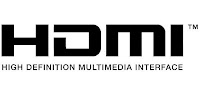 HDMI (High-Definition Multimedia Interface) is a connection standard that was first developed by Hitachi, Panasonic, RCA, Silicon Image, Sony, and Toshiba in 2002. HDMI is quickly emerging as the connection standard for HDTV in the consumer electronics market. HDMI is the first and only digital interface that is able to combine uncompressed audio and video over a single cable. Possessing a bandwidth of 5 Gbps, transmissions over HDMI are currently using less than half of that. This leaves plenty of room to expand the technology in the future.
HDMI (High-Definition Multimedia Interface) is a connection standard that was first developed by Hitachi, Panasonic, RCA, Silicon Image, Sony, and Toshiba in 2002. HDMI is quickly emerging as the connection standard for HDTV in the consumer electronics market. HDMI is the first and only digital interface that is able to combine uncompressed audio and video over a single cable. Possessing a bandwidth of 5 Gbps, transmissions over HDMI are currently using less than half of that. This leaves plenty of room to expand the technology in the future.HDMI is fully backwards compatible with DVI, and will supplant it as the interface of choice over the next few years.
HDMI - High Definition Multimedia Interface
DVI and HDMI are fully interchangeable using HDMI-DVI adapters, which are available here. The HDMI specification supports long copper cable lengths up to 15 meters, and even longer lengths are supported with the use of fiber optic technology. Click here to view our entire selection of HDMI cables.
HDMI also supports HDCP. HDCP stands for High Definition Content Protection. It is a specification that was developed by Intel Corporation (with input from Silicon Image) to protect digital entertainment content across both the DVI and HDMI interfaces.






0 komentar:
Posting Komentar